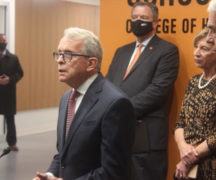Ohio Capital Journal
Two mega-corporations appear to be claiming they did the same work for Medicaid — Ohio’s $24 billion-a-year program that provides health care to the poorest 25% of state residents.
Since the companies received at least $53 million for the work in 2017 alone, the conflicting claims could be a big problem — one with potential implications in the many states where the companies do Medicaid business.
Ohio Attorney General Dave Yost last month filed suit against Centene, the largest Medicaid contractor in the United States, accusing it of charging the state for services it didn’t perform, among other things.
In a motion filed April 2, Centene strongly denied the accusations. But it also said that it provided services that its contractor, CVS Caremark, had already said it provided.
“There are no secrets here; there is nothing that needs to be hidden or, in fact, that even justifies the filing of this lawsuit,” Centene said in its court filing.
However, Centene, the nation’s 42nd-largest company, declined to answer questions about the division of labor between its subsidiary and CVS, the 5th-largest corporation in the United States. CVS, which does business with Centene in other states, didn’t respond to questions.
St. Louis-based Centene’s subsidiary, Buckeye Health Plan, was one of the five Medicaid managed-care plans that served in Ohio from 2017 until this year. The plans coordinate care for the bulk of Medicaid recipients. They sign up clients, create networks of medical providers such as pharmacies, and they handle payments for services.
After years of accusations that pharmacy middlemen hired by the managed-care companies were unfairly profiteering off of Medicaid drugs, the Ohio Department of Medicaid this year switched to a single middleman, or pharmacy benefit manager. It also required that the middleman work directly for the Medicaid department so that officials could get a better picture of what was happening with the department’s $3 billion-a-year prescription-drug benefit.
On Friday, the Medicaid department announced that it had hired six managed-care providers. Buckeye was at least temporarily ousted because the Medicaid department is suing its owner, Centene.
The suit against Centene, which itself was unsealed Friday, says that Centene-owned Buckeye “knowingly provided inflated pharmacy cost information to (the Medicaid department) as part of a deceptive scheme designed to maximize the profitability of its parent company, Centene, at the expense of the Ohio Medicaid Program and the citizens of the state of Ohio.”
As an example, it said that a Centene subsidiary marked up its bill for prescription drugs by $400,000 in a single week in 2018.
One “deceptive scheme” the suit is accusing Centene of is charging the state $1.45 per-prescription in pharmacy-dispensing fees and pocketing the money instead of passing it along to pharmacists — who were complaining that their Medicaid reimbursements were so low that they often couldn’t cover expenses.
The dispensing fees pocketed by Centene add up to real money. In 2017 alone, its managed-care organization, Buckeye, paid for more than 4.6 million generic prescriptions, so Centene would have pocketed at least $6.7 million in dispensing fees instead of passing them along to pharmacists.
“This practice is facially deceptive,” the state’s lawsuit, which is based on claims data from more years than just 2017, says. A Centene subsidiary “never directly paid any amounts to pharmacy providers as dispensing fees yet, with the full knowledge of Centene and Buckeye, represented on its invoices it was doing so.”
In its April 2 court filing, Centene didn’t deny pocketing dispensing fees. It said its contract didn’t prohibit the practice.
“While the complaint has these facts correct, it again demonstrates a misunderstanding of (the Medicaid department’s) own business methodology: the challenged conduct is entirely appropriate under (the Medicaid department’s) spread-pricing contracts,” it said.

A question at the heart of the suit seems to be who provided what pharmacy services and how much they were paid. And that boils down to which health care giant you believe — Centene or CVS.
Huge amounts of money are likely riding on the answer.
Until this year, other Medicaid managed-care companies in Ohio contracted directly with pharmacy benefit managers such as CVS Caremark, OptumRx and Express Scripts to handle various aspects of pharmacy benefits. Their services include creating pharmacy networks, creating lists of preferred drugs or “formularies,” negotiating rebates with manufacturers and reimbursing pharmacists, or “claims reconciliation.”
In 2016, Centene did something unusual when it acquired PBM services.
Its managed-care organization, Buckeye, employed another Centene subsidiary, Envolve, to handle the pharmacy benefit. Envolve hired yet another Centene subsidiary, Health Net Pharmacy Solutions, which contracted with CVS Caremark.
The largest pharmacy benefit manager — or PBM — in the country, CVS Caremark would have been attractive to Centene.
It could use its market dominance to force pharmacies into contracts that provided low reimbursements and low dispensing fees. In addition, it was already providing a full suite of PBM services to most of Ohio’s Medicaid managed-care companies.
But despite CVS’s size and sophistication, Centene claimed in court documents that CVS only handled “a limited, albeit important, set of PBM duties” for Buckeye.
That claim seems to conflict with an analysis of 2017 generic drug reimbursements to the state’s five Medicaid managed-care organizations. It found that at $53 million, Centene’s Envolve and CVS Caremark were pocketing more than twice as much per generic prescription than the PBMs serving the other four Medicaid managed-care providers.
That hefty amount was revealed amid suspicions that all the PBMs were overbilling for generic drugs. The analysis found that in 2017, the PBMs billed taxpayers almost a quarter-billion dollars more for generics than they passed along to the pharmacies that had bought and dispensed them.
In fact, the revelation that the PBMs were pocketing such huge amounts was a major reason for the sweeping reforms that the Medicaid department is implementing now.
The analysis of 2017 transactions also found something that doesn’t make sense if you believe that CVS handled only a “limited” set of duties while Envolve shouldered the biggest part of the load: CVS got $33 million, or 62%, while Envolve was paid just $20 million, or 38%, for handling Buckeye’s generic drug benefit.
Even so, in its motion this month, Centene said that Envolve, its PBM, had done the lion’s share of the work. It cited a 2016 email from its managed-care organization to an official with the Medicaid department.
“We are only sub-delegating claims payment processing — Caremark will not be doing any (prior authorization) or (utilization management) functions for our members,” it said.
Two years later, a starkly different picture emerged.
In 2018 the Medicaid department was asked what services Centene’s Envolve provided in 2017 for the $20 million it was paid. Medicaid officials replied, “utilization management, specialty management, data analytics, drug utilization review and formulary management.”
But when the Columbus Dispatch asked CVS if it had provided those services, it said it had. The company later tried to walk back its answer by claiming that Centene and CVS each provided unique services under those categories.
In its April 2 court filing, Centene said it “retained the leading role” in providing a number of services, including some that CVS said it provided, such as formulary management, utilization management and data analytics.
Even if one accepts that CVS and Centene were not paid to provide duplicate services, their claims still don’t square with Centene’s 2016 email. It said CVS would only handle claims-management processing and it specified that CVS would nothandle utilization management.
Centene last week again declined to clearly delineate what services its PBM provided and which were provided by CVS in 2017. Nor did it explain why its taxpayer-funded managed-care organization paid more than twice the (possibly inflated) going rate to handle generic drug transactions.
“While your questions contain material mistaken assumptions, for obvious reasons, we will not be litigating this matter in the press,” the company said in an email. “In our viewpoint, the claims asserted in Ohio are unfounded. Envolve Pharmacy Solutions has saved millions of dollars for taxpayers when compared to market-based pharmaceutical pricing.”
Centene added that it stands by the value and integrity of its services and added that it looks forward to defending against the state’s suit.
And, even as it refused to answer questions about what it did for millions of taxpayer dollars, it said, “Our company is committed to the highest levels of quality and transparency.”
While CVS didn’t respond to a request for comment, the state’s lawsuit seems to be supporting that corporation’s version of events.
It said that Centene’s deal with CVS Caremark meant “that by mid-2016, Caremark was handling most of the pharmacy-benefit management responsibilities for Buckeye and was doing so for significantly less than Envolve was billing Buckeye for the work. These cost savings were not disclosed to (the Medicaid department) and were not passed on to (the Medicaid department) or the State.”
Hopefully, who did what — and exactly how much each has been paid over the past five years — will be fleshed out as the lawsuit progresses. It would provide an important peek behind a very expensive curtain.
***
Also from Ohio Capital Journal:
Details emerge on proposed bill to restrict ‘vaccine passports’ in Ohio
Republican-sponsored legislation will seek to prohibit the Ohio government from instituting a “vaccine passport” program, but the drafted proposal does not appear to restrict private businesses from doing so.
Rep. Al Cutrona, R-Canfield, is soon introducing this bill in the Ohio House of Representatives. It has already received support from fellow Republican lawmakers.
The term “vaccine passport” refers to showing proof of COVID-19 vaccination that could allow entry into a given place or public event.
The vaccine is optional in Ohio, and Gov. Mike DeWine has given no indication the state government will develop a vaccine passport program here.
There are, however, some businesses, airlines, schools and governments considering such a program. Elsewhere, the state of New York has rolled out a digital “Excelsior Pass” system in which a person shows proof of a vaccination or a negative COVID-19 test to visit participating event centers such as Madison Square Garden and Yankee Stadium. READ MORE
Federal funding for low-income families stayed in state coffers amid pandemic
State records show as the state went through a pandemic and many Ohio families lost their jobs, the state’s balance in federal and state funding meant for assistance to low-income families continued to grow.
Ohio receives $725.6 million yearly from the U.S. Department of Health and Human Services for the Temporary Assistance for Needy Families (TANF) block grant, and the state is required to contribute as well, in a fund called a maintenance of effort (MOE). This amounts to $416.9 million per federal fiscal year, according to the state.
A breakdown of the TANF block grant from the state’s Office of Fiscal & Monitoring Services for the last budget cycle showed steady increases in the leftover TANF funding, from $95 million in fiscal year 2011 to $522 million in fiscal year 2017.
Budget estimates in 2018 put the leftover balance of TANF grant funds at $570 million, before dropping to an estimated $422 million for the 2019 fiscal year. READ MORE





